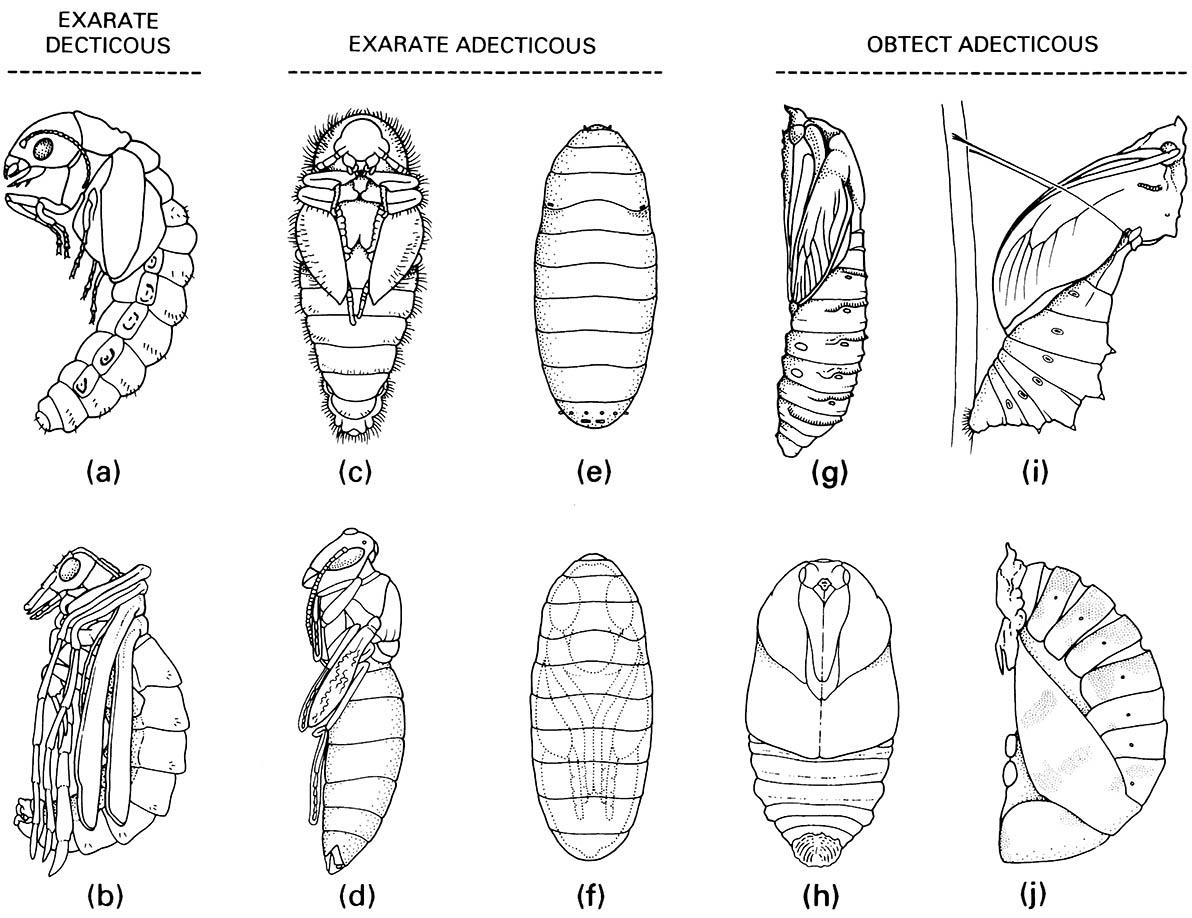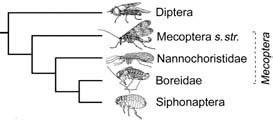Box 13.5. Mecoptera (scorpionflies, hangingflies)
The Mecoptera is an order of about 550 known species in nine families, with common names associated with the two largest families — Bittacidae (hangingflies, see Box 5.1) and Panorpidae (scorpionflies, illustrated in the Appendix; see also Plate 5.3, facing here, and the vignette of this chapter). Development is holometabolous. Adults have an elongate hypognathous rostrum; their mandibles and maxillae are elongate, slender, and serrate; the labium is elongate. They have large, separated eyes, and filiform, multisegmented antennae. The prothorax may be smaller than the equally developed meso- and metathorax, each with a scutum, scutellum, and postscutellum visible. The fore and hind wings are narrow and of similar size, shape, and venation; they are often reduced or absent. The legs may be modified for predation. The abdomen is 11-segmented, with the first tergite fused to the metathorax. The cerci have one or two segments. Larvae possess a heavily sclerotized head capsule, are mandibulate, and have compound eyes. Their thoracic segments are about equal; the short thoracic legs have a fused tibia and tarsus and a single claw. Prolegs usually occur on abdominal segments 1–8, and the (10th) terminal segment bears either paired hooks or a suction disc. The pupa (Fig. 6.7b) is immobile, exarate, and mandibulate.
The dietary habits of mecopterans vary among families, and often between adults and larvae within a family. The Bittacidae are predatory as adults but saprophagous as larvae; Panorpidae are scavengers, probably feeding mostly on dead arthropods, as both larvae and adults. Less is known of the diets of the other families but saprophagy and phytophagy, including moss-feeding, have been reported.
Copulation in certain mecopterans is preceded by elaborate courtship procedures that may involve nuptial feeding (Box 5.1). Oviposition sites vary, but known larval development is predominantly in moist litter, or aquatic in Gondwanan Nannochoristidae.
Phylogenetic relationships are considered in section 7.4.2 and depicted in Figs. 7.2 and 7.6.

Exarate decticous pupae: (a) Megaloptera: Sialidae; (b) Mecoptera: Bittacidae. Exarate adecticous pupae: (c) Coleoptera: Dermestidae; (d) Hymenoptera: Vespidae; (e,f ) Diptera: Calliphoridae, puparium and pupa within. Obtect adecticous pupae: (g) Lepidoptera: Cossidae; (h) Lepidoptera: Saturniidae; (i) Lepidoptera: Papilionidae, chrysa lis; (j) Coleoptera: Coccinellidae. ((a) After Evans 1978; (b, c, e, g) after CSIRO 1970; (d) after Chu 1949; (h) after Common 1990; (i) after Common & Waterhouse 1972; (j) after Palmer 1914)

Broken lines indicate uncertain relationships. Thysanura sensu lato refers to Thysanura in the broad sense. (Data from several sources)

The broken lines indicate a paraphyletic taxon, with its name italicized; s. str. refers to the restricted sense. (After Whiting 2002)



